THE BFS BOX SQUATUnfortunately the safety of this antastic Core Lift is questioned because of misconceptions that it compresses the spine and is dangerous to the lower back. We know this is an effective and safe lift<By Dr. Greg Shepard Published: Winter 1997 I learned about the Box Squat from two throwers in Los Angeles in the late 1960’s. George Frenn was our nation’s best Hammer thrower and John Cole was one of the best Discus throwers. Both George and John were also world record holders in Powerlifting. We first trained at the original Gold’s Gym in Venice Beach and then later at the West Side Barbell Club. Louie Simmons, who has trained many Powerlifting record holders, also learned about Box Squats at the same place. He took this knowledge back to Columbus, Ohio and now has his own West Side Barbell Club. There are misconceptions that Box Squats compress the spine and/or are dangerous to the lower back. There is even a poster in a number of weight rooms describing these two misconceptions. As a result, most people don’t know the advantage of this superior BFS core lift. At BFS Clinics, we usually select a junior running back and put him through an intense, all out Box Squat effort. The last set is done for 11 repetitions with 350 to 500 pounds. The goal is to select a weight high enough so that it takes everything the athlete has to get the 11th rep. We want him exhausted. However, to motivate the athlete to do his absolute best, we challenge him to a weight he never thought he could do and we have everyone screaming and clapping in unison. It’s one amazing scene. Before this event, we have the athlete test his Vertical Jump on a basketball hoop in the gym. We give him about 5 trials and question him about his effort. We want to know how high they can go or have gone. Then about an hour after the Box Squat demonstration, this same athlete jumps again. Guess what? He will jump as high or higher than ever before. This has far reaching implications. This Vertical Jump result would have been absolutely impossible with Parallel Squats. They leave your legs wobbly and drained even on the next day if the effort has been intense. Because of the rapid recovery of the Box Squat, even though it may be only two inches above a true Parallel Squat, in-season and off-season training can now take on a whole new perspective. ADVANTAGES OF THE BOX SQUAT There are five distinct advantages the Box Squat offers. In the BFS Program, true Parallel Squats are done once a week as are Box Squats and you do them all year round both in-season and off-season. Other Squat Variations such as Front Squats can be done instead of Box Squats. However, the Squat variation of choice is the Box Squat especially for the high school athlete and for all athletes during the season. I. Plateaus: Variation is the key to overcoming plateaus. The idea for high school and college athletes is to continually get stronger. Nobody likes plateaus in strength training. Variation can come in many forms but one of the best ways to eliminate plateaus is to do another kind of squat. As stated earlier, we like the Box Squat. If you Parallel Squat the same way two or three times per week, just as surely as the sun comes up each morning, you will experience a plateau. If you do Box Squats once per week instead of another Parallel Squat workout, your strength on the Parallel Squat will increase more rapidly and at a more steady pace than just doing Parallel Squats all the time. II. Hip and Hip Tendon Strength Development: The Box Squat Movement of settling back with the hips and then surging forward and up makes this exercise unequaled in developing hip and hip tendon strength. This movement also duplicates a block, tackle or vertical jump. The Box Squat can be used as an excellent tool in teaching correct athletic mechanics as you develop the hips and the hip tendons. III. More Weight, More Confidence: A coach, at first glance, may say, “well sure you can lift more weight than a Parallel Squat because you are two-inches higher.” Yes, that is true but there are two other reasons which must be considered. First, the most powerful muscles and area of the body are centered in the hips, buttocks and pelvis. The Box Squat maximizes these areas and thus even the most inexperienced lifters can lift a lot of poundage during the first initial workouts. This builds confidence. Second, it is much easier to maintain a perfect squatting power position on a Box Squat when compared to a Parallel Squat. Thus, anyone can lift more weight safely which boosts confidence. For example, an athlete who struggles with 200 pounds on a Parallel Squat could most likely Box Squat 275 pounds with perfect form. IV. Recovery Both In-Season and Off-season: As discussed in the Box Squat event at BFS clinics, the Box Squat is truly amazing as far as quick recovery. This fact has far reaching implications in the implementation of your total strength and conditioning program. During the season an athlete or team now has the luxury of working out the day before the game if necessary. This means a Thursday Box Squat workout is fine before a Friday night football game. You can workout Monday before a Tuesday basketball game and so forth. This means, if the BFS Total Unified Program is implemented, that a three-sport high school athlete can get two great squat workouts in per week all-year-round. During the off-season an athlete who Box Squats on Monday can enjoy a quality speed and plyometric workout on Tuesday. Thus, the Box Squat trained athlete usually has greater speed, explosive power and jumping improvement. V. Learning to Squat: Basic squatting principles and technique are far easier to teach and learn with the Box Squat than Parallel, Front or even Half Squats. Even in very difficult cases, athletes can keep upright with a locked-in lower back when doing Box Squats. It would be almost impossible to find any athlete who couldn’t Box Squat with reasonable form on the first day. This includes girls and boys from the seventh grade on up. Common problems encountered in teaching the Parallel Squat are easily overcome with the Box Squat. For example, the problems of keeping the heels flat on the floor or extending the knees forward or rounding the back are almost naturally done correctly with the Box Squat. It is also very easy to set an athlete on the box or a chair and get everything (knees, feet, chest, head, lower back and eyes) looking perfect. THE BASIC BOX SQUAT TECHNIQUE First, assume an athletic stance and squat done carefully under control on a box, high bench or BFS Squat Box. Take care not to plop down hard or out of control as this could cause injury, although the Box Squat is very forgiving. When contact is made, settle back in a backward rocking motion putting the weight back on the glutes and hips. Make sure the lower back remains concave in a “locked-in” position. Then, shift your power upward to drive the hips and legs in a forward, upward surge of momentum. Make sure you use your powerful hip and buttock muscles including the tendons. If you go down and just touch the box, or bench, like most people, then all you develop are the quadriceps. This would be a serious mistake for an athlete. Finally, the athlete should drive up on his toes in an explosive type action at the last part of the lift. If the weight is too heavy to do this, the athlete should always try and have the feeling of coming up on the toes. The athlete should have the same feeling of blocking, tackling, rebounding or releasing a track implement at this final stage. THE FINER POINTS Obviously the height of the box makes a difference in the amount of weight that can be handled. The ideal starting point is about two-inches above parallel. Sometimes the tall, skinny athlete needs a higher level in order to get his technique correct. The same is often true with the over-fat younger athlete. The bottom line is control. If the athlete can’t control his downward movement without plopping, then simply raise the box. Normally, I l |
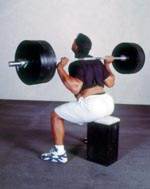 |
|
Detroit Lion - Luther Elliss 6'5 300 lbs doing the Box Squat |
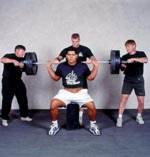 |
|
As with all lifts, proper spotting technique is as important as lifting technique. Stay alert watch carefully and be smart. |
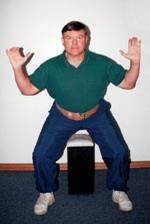 |
|
Coach Shepard practicing the Box Squat without a bar. Look straight ahead, sit down under controll, rock back slightly on the hips, surge forward and upward and raise up on toes to finish the movement. |
 |
|
This is a recent photo of Greg Shepard on the Box Squat. Notice the natural position of the knee and lower leg which is perfect. It is easy to sit tall and spread the chest while sitting on the box. |
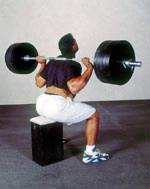 |
|
|
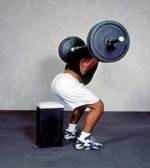 |
|
|
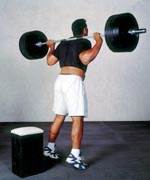 |
|
|